PORTUGAL 2025
I'm always watching for flight deals, there are many different sites that can be useful, but YVR Deals has been one of the ones that stands out if you live in the Vancouver area. We found great deals for Japan, Iceland, New Zealand to just name a few, so when a great price popped up on return flights to Portugal, we jumped on it, as it has been on our list for a long time. A whole bunch of research, and a rough itinerary was planned to visit the core areas of Portugal including one of their Island destinations. We would fly in and out of Lisbon, with a short flight to Madeira in between... now just to wait for travel day.

Before we get started, if you are one of those people that says "If you
have seen one Church/Cathedral, you have seen them all", this is not
going to be a travel blog that you may appreciate. Portugal has a lot of
churches/Cathedrals, and they are all quite unique and different, even if there are some
similarities. So be prepared to scroll a little faster at times if that is something that
doesn't interest you.
I will frame that info if you want to skip the historical details.
Lisbon
February 26



Our Air Canada flight via Montreal actually arrived in Lisbon early and we were picked up by a driver and taken to the Chiado 44 hotel in a historic district central to Lisbon. PRO TIP: It is well worth the extra money to pay for an extra night if you arrive early so you can check in to your hotel right away and not have to wait until the afternoon to get in your room. After a brief nap, we headed out to check out the nearby areas of the city, and while we were gone they upgraded our simple room to a suite.




The views weren't amazing, but it was within walking distance of key areas of Old Lisbon.


Just a short distance from our place and we are seeing all kinds of history, with beautiful squares and tilework.























We made our way past all the Tuk-Tuks and electric Chinese "Classic Cars" to the waterfront.




Along the waterfront is the Praça do Comércio Square, it was completely rebuilt after the 1755 earthquake that levelled most of the city. This will not be the last time that you hear about this earthquake.






The Arco da Rua Augusta is a stone, memorial arch-like, historical building on the Praça do Comércio. It was built to commemorate the city's reconstruction after the 1755 earthquake.







Sé de Lisboa (Cathedral of Lisbon) construction began in 1147, considered the oldest church of the current Portuguese capital.
















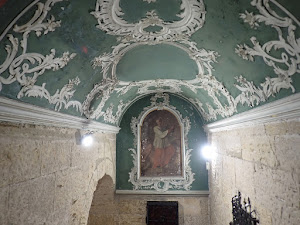







The 7 story Elevador de Santa Justa connects the lower streets of the Baixa with Largo do Carmo (Carmo Square). Construction started in 1900, originally powered by steam, the lift was converted to electrical operation in 1907








Museo Arqueológico do Carmo is housed in the ruins of the old Church of the Convent of Santa Maria do Carmo, founded in 1389. Carmo was one of Lisbon’s most beautiful Gothic churches until the 1755 earthquake caused serious damage to the building and destroyed almost all of its religious-artistic possessions. Reconstruction work started in 1756 but was definitively suspended in 1834, leaving the naves and transept without cover and the chapels incomplete, when the religious orders in Portugal were abolished.







Ginjinha is a Portuguese liqueur made from aguardente (brandy or fortified wine) that’s been infused with sour cherries, sugar, and cinnamon. It’s dark red, super sweet, and surprisingly strong, with an alcohol level of around 18–24%. Scattered throughout the city are little stands and bars selling Ginja, the best ones sell them in shot glasses made of chocolate... shoot the drink, eat the glass. Apparently it was given as a free gift to welcome people into the castle, and they realized that it could make them money. Well worth it! This shop gave you a free refill if you could hold off eating the chocolate glass long enough.




Praça do Rossio (King Pedro IV square) became an important place in the city during the 13th and 14th centuries.







We spent some time watching this student group perform and dance in the square.






The mosaic tile work throughout the city in squares, pedestrian streets and sidewalks are amazing, and also very slippery when wet.


Fado is a music genre which can be traced to the 1820s in Lisbon, Portugal. It is a form of music characterized by mournful tunes and lyrics, often about the sea or the life of the poor, and infused with a sense of resignation, fate and melancholy. A visit to Portugal isn't complete unless you sit in a small restaurant listening to the sad songs being sung accompanied by a guitar and Portuguese guitar.


Luckily for us, the restaurant we chose, Taberna da Má Fama, was alternating singers and had decent food and drinks.





The main guitarist had a very unique instrument, and I asked him what it was called, his response "Portuguese Guitar".
February 27
I surprised Norine with a 1/2 day Tuk-Tuk tour of Lisbon with Emanuel R Silva. He was incredibly personable, full of energy, and very funny. Be prepared to hear about the earthquake of 1755, because we heard about it all day long.


The first stop is Livraria Bertrand, the world's oldest bookshop, dating back to 1732



Of course we had to buy an appropriate book from here, our copy of Two Nights in Lisbon has a stamp certifying it was purchased at the oldest bookshop in the world.


Next to the bookshop is the Basílica Dos Mártires. Originally built in 1147, it was completely rebuilt after the 1755 earthquake.






Also beside the church is a little old lady that has been selling cork bags and items for what Emmanuel describes as over 100 years. She never takes a day off, and he tells us she has the best prices, riiiiggghhhtttt.
The Café A Brasileira (The Brazilian Café) is one of the oldest and most famous cafés in the old quarter of Lisbon and constantly active. The shop was opened to import and sell Brazilian coffee in the 19th century, then a rarity in the households of Lisbon. Over time the space became the meeting point for intellectuals, artists, writers and free-thinkers. A bronze statue of the 19th century Portuguese poet Fernando Pessoa sits permanently outside, where he often sat drinking absinthe and coffee.



Our next stop was a rainy lookout at Miradouro São Pedro de Alcantra.




The next stop at Parque Eduardo VII was just as rainy.

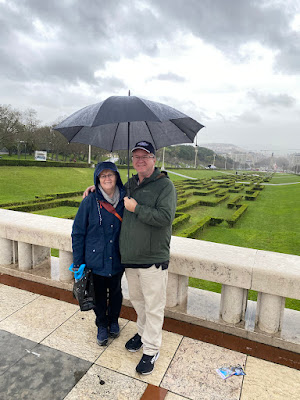



When we arrive in the Belem area, we are rerouted numerous times, as the French Prime Minister Macron is visiting. Guards are everywhere and we are treated to a massive horse parade while we circle the area trying to get to the Monastery. The Pasteis de Belem was our true destination for the most delicious desert, an amazing custard tart available throughout the country, but perfected here. We had a very nice lunch of classic Portuguese pies and desserts.







Apparently our guide knows everyone, and we get a personal demonstration of the making of the Pasteis pastry.


We weren't able to visit the Jerónimos Monastery with the political visit going on, but the building is very impressive from the outside.


Almost as impressive was this Raccoon graffiti made completely of garbage, apparently the artist has created art installs like this throughout the country.


The Monument to the First Aerial Crossing of the South Atlantic consists of a stainless steel replica sculpture of Fairey III biplane, that was used by Gago Coutinho and Sacadura Cabral during their 1922 South Atlantic aerial crossing.


The Belem Tower was built to defend Lisbon from enemy ships. Around 1515, architect Francisco de Arruda designed the iconic monument and it served the purpose of being a fort that protected Lisbon from incoming raids along the Tagus River. It also marked the beginning of voyages for sailors. Years later, the tower was transformed into a lighthouse and then a customs center.
Lisbon's Monument to the Discoveries commemorates the five hundredth anniversary of the death of Henry the Navigator, who discovered the Azores, Madeira, and Cape Verde. The rain and wind was so bad here it destroyed our umbrella.







From Belem it was back into the center of Lisbon and the very rainy Santa Luzia viewpoint.









We were dropped back in town and wandered past the unique locations assortment of shops, and headed back to the hotel to dry off. We had dinner at a local Portuguese style restaurant called Toma Lá Dá Cá. If you didn't look closely you could have walked right past it, not knowing there was a restaurant there. The food was very good and quite inexpensive.


February 28
On a cloudy and wet morning, we are picked up by our next tour guide Ana for a day trip to Sintra. A moments wait while her trainee Matild walks up to meet us. As soon as she gets in the car, Ana lectures her on smoking... it could be a long day.


It's about a 45 minute drive to Peña Palace, we get a lot of Lisbon history along the way, including the Earthquake of 1755. One of the benefits of coordinating this day trip with an experienced guide, was that our tickets were pre-arranged, and Ana knew the tricks to get us into the palace grounds before the crowds, and bypass some of the waits you would have arriving on your own.



Unfortunately the fog rolled in and we didn't get the full colourful experience of the palace, but it was unique emerging from the mist.


The Palace of Pena site dates back to the 12th century, a point in time when there was a chapel dedicated to Our Lady of Pena here. On this same location, King Manuel I ordered the construction of the Royal Monastery of Our Lady of Pena. The earthquake which struck Lisbon in 1755 left the monastery practically entirely in ruins. However, even while stricken, the Monastery remained active and it would only be almost a century later, in 1834, following the abolition of religious orders in Portugal, that it was abandoned.







The original 19th century restoration project was to create a summer residence for the royal family, but Ferdinand II's enthusiasm led him to opt for the construction of a palace and extending the pre-existing construction. The building is circled by other architectural structures that appeal to the medieval imaginary, such as the parapet paths, the lookout towers, an access tunnel and even its own drawbridge. The palace incorporates architectural references displaying Manueline and Moorish influences that together produce a surprising scenario recollecting “a thousand and one nights.” The Palace of Pena was classified as a National Monument in 1910 and ranks as the single most important site in the Cultural Landscape of Sintra, classified by UNESCO as World Heritage in 1995.


















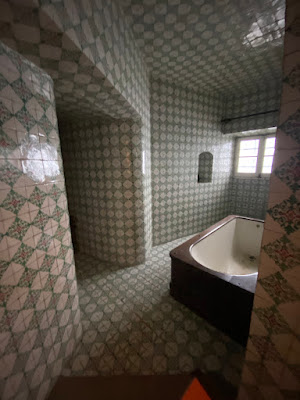

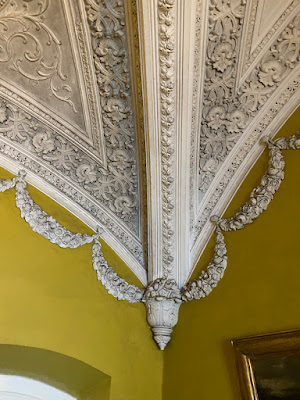











































After visiting the palace, we are given some time to wander around the town of Sintra, finally the fog is starting to lift.





















The National Palace of Sintra (Palácio de Sintra), also called Town Palace (Palácio da Vila), is a present-day historic house museum. It is the best-preserved medieval royal residence in Portugal, being inhabited more or less continuously from at least the early 15th century to the late 19th century. The 2 conical chimneys are what remains from the moorish kitchens that are part of the palace.








Biester Palace Fonte dos Pisões built in 1931 to replace a previous fountain.


Quinta da Regaleira consists of a Romantic palace and chapel, and a luxurious park that features lakes, grottoes, wells, benches, fountains, and an array of exquisite constructions. The palace is also known as "The Palace of Monteiro the Millionaire", which is based on the nickname of its best known former owner. Monteiro added enigmatic buildings that allegedly held symbols related to alchemy, Masonry, the Knights Templar, and the Rosicrucians. The architecture Manini designed evoked Roman, Gothic, Renaissance, and Manueline styles. The construction of the current estate commenced in 1904 and much of it was completed by 1910.






















The Poco Iniciatico (Initiation Wells) are two wells on the property that better resemble underground towers lined with stairs. These wells never served as water sources. Instead, they were purportedly used for ceremonial purposes. These wells are connected to one another with tunnels, in addition to various caves and other monuments located around the park. Of the two wells, the larger one contains a 27-metre spiral staircase with 23 small niches on the side. The nine flights of stairs could be linked to the Knights Templar, which had nine founders. They might also symbolize the 9 levels of Hell from Dantes’ Inferno. At the bottom of the well is an inland stone compass with the Templar cross. Carvalho Monteiro was possibly an initiate of the Knights Templar, a Catholic military order. This medieval order originated in the early 1100’s and likely disbanded in the 1300’s. However, groups like the Freemasons revived their rituals and traditions hundreds of years later.
















The Fonte da Abundância is not new. the fountains construction dates back to ancient times, having been built in the 18th century. Over the centuries, the Fonte da Abundância has served the local population, providing water for consumption and other uses.















The detail in the woodwork on the floors and ceilings is incredible.















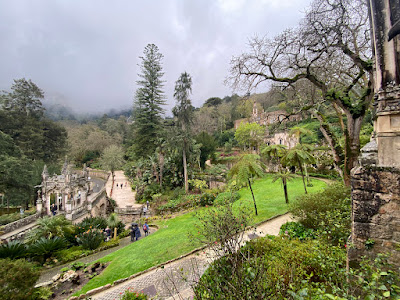

Ana and Matild wait in the car below for us, hopefully they are getting along better.


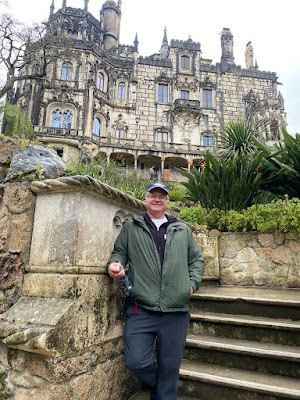


The Moorish Castle is still in the fog as we leave.


The history of Palacio de Monserrate starts out in
1540, the point in time when Friar Gaspar Preto ordered the construction of a hermitage
here dedicated to Our Lady of Monserrate, following a journey across the Iberian Peninsula
when he marvelled at the hermitage of Montserrat nearby Barcelona, in Catalonia. The 1755
earthquake of Lisbon devasted the site, leaving a major trail of destruction. Even in poor
condition, the site was rented in 1789 by a British trader who ordered the building of a
Neogothic castle there but in which he was to reside for only a few years. In 1794, a
British writer became the new tenant of Monserrate. Subsequently, he commissioned
restoration and improvement works on the building and its immense surrounding gardens.
The site was again doomed to abandonment in 1799 when the writer moved out of the
property. in 1863, following such a succession of owners, histories, restorations and
abandonments, Francis Cook, a British trader and art collector, became the owner of the
Estate of Monserrate and the 1st Viscount of Monserrate. There, he commissioned the
construction of the palace that combines Gothic and Indian influences with Moresque
suggestions. The exotic and foliage motifs on the interior decoration extend harmoniously
to the exterior that was also reformulated and transformed into one of the finest of all
Portuguese botanical gardens.


After leaving Sintra we were taken to the Nortada Seaside restaurant outside Cabo da Roca. This is where Norine learned about green wine... not green in colour, but using less ripened green grapes.The food was very good, but I always find it odd when a tour guide won't eat lunch with you.






Next up was the Lighthouse at Cabo de Roca, situated on a promontory made up of granite boulders and interspersed limestone. It originally began operating in 1772. It was the first new purpose-built lighthouse to be constructed in the country.











After wandering around the Lighthouse and cliffs of Cabo da Roca, we piled back in the van and headed back to Lisbon.


To finish off the tour Ana drops us off at the Igreja de Sao Roque Church of Saint Roch, and comes inside to give us additional information.



The Igreja de São Roque was the earliest Jesuit church in the Portuguese world, and one of the first Jesuit churches anywhere. It was one of the few buildings in Lisbon to survive the 1755 earthquake relatively unscathed. When built in the 16th century it was the first Jesuit church designed in the “auditorium-church” style specifically for preaching. Fascinating to learn that the painting above the alter is on a rotating column that allow the church to change the painting based on the different seasons of the year. It contains a number of chapels, most in the Baroque style of the early 17th century. The most notable chapel is the 18th-century Chapel of St. John the Baptist, a project constructed in Rome of many precious stones and disassembled, shipped, and reconstructed in São Roque; at the time it was reportedly the most expensive chapel in Europe.
















We left Ana and Matild behind and walked back through the city to an area known as the Green Street on Rue da Silva






We took a break and had a few drinks while people watching amongst the plants, then headed back to our room, all uphill.



Kristen, an old colleague of mine from EA had moved to Lisbon, and she reached out to meet us for dinner. One of the recommendations from Emanuel was the Sea Me restaurant right near to where we are staying, she had never been there, so we chose it. Turns out there is two Sea Me restaurants on the same street, Sea Me Next Door, and Sea Me Peixaria Moderna. She waited at one and we waited at the other, Kirsten's was nicer and didn't have a long wait, so we walked down a block to meet her.




The walk was well worth it, we were given a tour of their fresh fish bar, and it was delicious. Later I found that our waitress that we asked to take a picture of us, also took one of herself... too funny.



It was so great to catch up with Kirsten, reminiscing about the old EA Sports days, discussing the adventures that brought her to Lisbon, and talking about travel. When we noticed it was already midnight, we said our goodbyes and headed back to our hotel to pack up for the next part of our adventure.
March 1
On our last day in Lisbon we are picking up a rental car and leaving Lisbon.


It's a beautiful and sunny day as we wait for our Bolt driver (it's a euro version of Uber) and get dropped at the Avis Car Rental office in the center of town. A nice looking Skoda Kamiq, roomy enough for our luggage to be hidden, and small enough to navigate the narrow streets we will encounter. It's nice to have Apple Carplay, as the combination of roundabouts and one way streets make getting out of the city feel like you are playing a giant escape the maze game.






